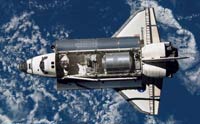Astronauts test shuttle wings with lasers and digital cameras
Discovery's astronauts used lasers and digital cameras to examine the shuttle's wings for any signs of launch damage as they gained on the international space station with every circling of Earth.

The good news was that Discovery's fuel tank did not appear to lose any significant amount of foam insulation during the crucial first two minutes of flight, said John Shannon, head of the mission management team.
"Overall, the tank performed extremely well," he said Wednesday.
More data and analyses are needed, however, before NASA can say with absolute certainty that the shuttle's thermal shielding made it through the launch damage-free.
The inspection carried out Wednesday is standard procedure, but it's an even higher priority this time because of questions about possible flaws in three wing panels.
Shannon said a preliminary look at the images revealed nothing of significance, but it will take another few days before experts on the ground finish analyzing everything.
Commander Pamela Melroy and her crew used a 100-foot (30-meter) boom to survey Discovery's wings and nose, which are exposed to as much as 3,000 degrees Fahrenheit (1,650 degrees Celsius) during re-entry. The inspection took a little longer than usual because NASA wanted to collect more detailed pictures of the wings, in particular the three suspect panels.
Before Tuesday's launch, a NASA safety group recommended that the flight be delayed because there may be some cracking beneath the coating on these three panels. But senior managers decided to proceed, saying it was an acceptable risk.
NASA wants to make sure none of the protective coating has chipped away and nothing else is wrong with the reinforced-carbon panels, before bringing Discovery home.
Columbia was destroyed during re-entry 4Ѕ years ago because of a hole in the left wing, left there by flyaway fuel-tank foam.
Just as important will be the hundreds of digital pictures snapped by the three space station residents as Discovery makes its final approach for Thursday morning's docking. The shuttle will do a slow-motion backflip, exposing its belly.
About six pieces of foam broke off Discovery's external fuel tank during launch and one or more may have even hit the shuttle, but it happened late enough to be of little or no concern. Shannon said nothing appeared to come off the tank's brackets, which were modified after a small piece of bracket foam came loose and gouged Endeavour's belly in August.
Mission Control sent a cheeky wake-up call to Discovery early Thursday morning, playing the song "Dancing in the Moonlight." The song begins with the lyrics "We get it on most every night, when that old moon gets so big and bright. It's a supernatural delight. Everybody was dancin' in the moonlight."
Answering the wake-up call was flight engineer Daniel Tani, who will take up residence Thursday in the space station, replacing Clay Anderson.
"It's moving day for me," Tani said. "I can't wait to settle into my new home."
Discovery is delivering a new room for the space station that's about the size of a school bus. It's the first live-in addition since 2001.
The pressurized compartment, called Harmony, will serve as the docking port for Europe and Japan's laboratories, which will be launched on the next three shuttle flights.
Onboard preparations for the docking and the first spacewalk of the mission, set for Friday, were interrupted by repeated computer and cable problems.
"We seem to have had more than our fair share of bad cables," Melroy said, sighing, as she struggled to get a continuous stream of readings from one of the shuttle's fuel cells.
Once Discovery arrives at the space station, the seven astronauts will have little if any time to deal with problems.
They're facing the most challenging construction work ever attempted in a single mission: installing Harmony, moving a massive girder and set of solar wings on the station, and pulling out those solar wings and radiators. Four spacewalks are planned to accomplish all this, and a fifth will demonstrate a repair method for shuttle thermal tiles.
Subscribe to Pravda.Ru Telegram channel, Facebook, RSS!


